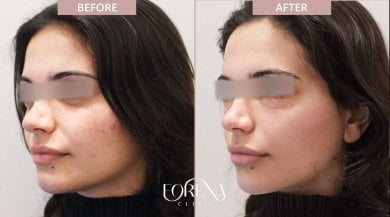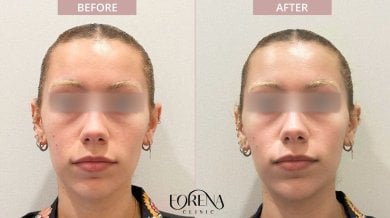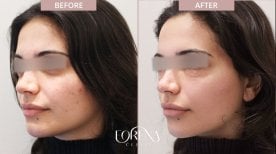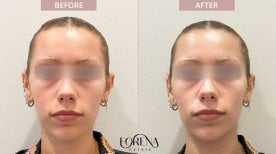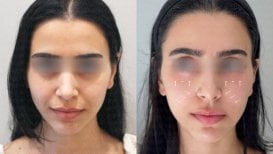- Yeom Jihye is a lifetime member of the Korean Society for Laser Dermatology and Hair Restoration.
- Forena Clinic offers the Signature Triple Toning and Signature Poretox (Xeomin) for advanced skin rejuvenation.
- Included Services: Signature Triple Toning, Signature Poretox (Xeomin), access to coffee zone.
- Stay Info: Accommodation is not included; no hotel stay required.
- Technique: Signature Triple Toning combined with Xeomin-based Poretox therapy for skin rejuvenation.
Skin Rejuvenation in Republic of Korea — get 3 top clinic matches with costs
How it works
How Much Does Skin Rejuvenation Cost in Republic of Korea?
The cost of skin rejuvenation in South Korea typically ranges from $300 to $400. Prices vary depending on the technology used (like laser resurfacing, RF microneedling, or chemical peels), the clinic’s reputation, and the number of sessions needed. In the United States, the average cost is $4,300 (according to the American Society of Plastic Surgeons). Overall, skin rejuvenation in South Korea is about 91% less than in the U.S.
Korean clinics usually include the initial consultation, the procedure itself, topical anesthesia, and post-treatment care in the price. In the U.S., costs often cover only the procedure, with extra charges for anesthesia, follow-ups, and aftercare products. Always confirm what’s included with your chosen clinic.
| Republic of Korea | Turkey | The USA | |
| Skin Rejuvenation | from $449 | from $1,200 | from $2,500 |
Medically reviewed by
Fahad MawloodOur Skin Rejuvenation Packages in Republic of Korea December 2025

- Dr. Byung-hee Lee is a founding member of the Korean Society of Interventional Neurology.
- RE:YOUTH (YONSEI BH Arterial Stemcell Clinic) specializes in arterial stem cell therapy in Korea.
- Included Services: Consultation with a doctor.
- Stay Info: 1 day stay in the hospital, 1 day stay in the hotel, accommodations not included in the price.
- Treatment Method: Arterial stem cell treatment for relief from menopausal vaginal dryness.
Discover the Best Skin Rejuvenation Clinics in Republic of Korea: 6 Verified Options and Prices
Skin Rejuvenation Overview in Republic of Korea
- Bookimed deposit: $200 or €200.
- Clinic deposit: Pay a set percentage in advance.
Our Trusted Doctors
View all DoctorsYeom Jihye
Minhee Ryu
Jiwoo Kim
Kim Han Kook
Video Stories from Bookimed Patients
Reviews about Bookimed: Discover Patients' Insights
All reviewsSkin Rejuvenation: Before & after photos
View allShare this content
FAQ about Skin Rejuvenation in Republic of Korea
What should you know about South Korea before the trip?
Currency | South Korean Won (you also can pay for services in dollars) |
Best period for the trip | April, May & June or September, October & November. |
Language | Korean (most of medical staff speaks English fluently) |
Visa | none required for stays under 90 days or less |
Time difference with Europe | 9 hours |
Time difference with the USA | 9 hours |
Capital | Seoul |
Medical tourism center | Seoul |
Popular resorts | Gangwon-do, Gyeongju, Boseong, Jeju |
What is the level of medicine in South Korea?
Healthcare is the key development sector of the Korean government. The Korean authorities are convinced that care for the citizens' health should be an absolute priority of state policy and spend about 1 billion a year for medical tourists attraction.
According to Mark Britnell, hospitals dominate the health system. 94% of hospitals are privately owned.
What hotel services are provided here?
In South Korea, hotels of different price ranges and service levels are presented. Most tourists choose 4 and 5 star hotels with all-inclusive meals. Such hotels have everything for a comfortable stay: varied food, a large well-groomed territory, animation for children and adults. Some hotels have their own water park, which guests can use for free. Budget travelers can afford to book an economical 3-star hotel with half board or no meals at all.
Do I need a visa to South Korea?
Today, South Korea has visa-free agreements with 112 states. None visa is required for stays under 90 days or less. To stay longer in this country, you need a visa. What states need a visa for treatment in South Korea and what countries can cross the border free and easy read here.
What documents are required to apply for a visa to South Korea for treatment?
Visas for travel to South Korea require a number of documents. The necessary papers can be submitted 90 days before the planned departure. Lists of documents includes:
- ID card
- confirmation of online registration and filling out the questionnaire
- certificate of income and availability of funds
- insurance policy for a stay in South Korea (original and copy)
- 2 photos (5x6)
- visa receipt
- booking of flight and hotel
- medical opinion about the need for treatment.
What are the most popular plastic surgery procedures?
According to ASPS statistics, 17.7 mln cosmetic surgeries and 5.8 mln reconstructive procedures have been performed in 2018. Among cosmetic procedures the most popular are:
- breast augmentation
- liposuction
- rhinoplasty (nose job)
- eyelid surgery
- tummy tuck.
Tumor removal, laceration repair, maxillofacial surgery, scar revision, hand surgery are the most common operations in the context of reconstructive surgery.

